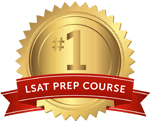Though it may not seem like it, I wasn't always a whiz at the LSAT. I had to drag my way up to the top through hard work and practice. I can still remember that first day I sat in some LSAT prep course and was handed back my practice LSAT score. I had gone into the exam blind and thought, how bad can this be? Well, my friends, it was bad. My heart sank as I saw there was no “17” in front of my score and there was no “16” in front of it either! How could this be?! I remember thinking, well, it was a nice run, LSAT; I just don’t think we can be friends. But, look at me now! I worked hard, reached well above my goal score and consider myself a LSAT connoisseur (a title I wear proudly), and so can you!”
As I'm sure all of you LSAT takers are aware, the climb of the LSAT score is a frustrating one. When your score is below the mid- to upper 150s, you find that your score jumps up rather quickly. And then you hit a wall I fondly call, "the epic 160 wall," a wall I remember quite well. Then one beautiful day, you score that practice LSAT test and see, OH MY! Your score has planted it's flag right smack dab on that "160 wall," (maybe even a bit further!) Again, the points come in quickly, but this time you're stuck at "the horrid above 165 wall."”
You work hard each and every day trying to break that barrier and yet that "above 165 wall" looks so far away. I like to equate the LSAT score to rock climbing. Now, mind you, I'm talking about belaying and not bouldering. Stay with me. If you miss your hold when you boulder, you risk falling to the ground and starting from the beginning. Whereas, when you are belaying, if you slip on a hold, you may slide down a bit, but with a trusty belayer and adequate rope and harness, you're still on your way towards the top. Likewise, your hard work and LSAT technique are your belayer and equipment. So, even though at times you may lose your grip on a hold or possibly even miss it from time to time, you won't have to climb all the way back up to where you were.”
Now the thing with climbing is that you're using muscles you may never have known existed. So you may be trying to complete a certain climb that seems impossible to you. How in the world am I going to get from this hold to that one?! But, the more you try, the more those secret muscles of yours are worked out, the more muscle memory you'll acquire and then one day, wham! You can reach the hold no problem and you're able to inch your way one more hold forward.”
What's my point? Well, my LSAT studiers, it is this:”
As long as you continue to practice and analyze what you do, you'll steadily climb up that path. Endurance and emotional resilience are key. I can’t tell you how many times one disappointing LSAT practice test score can make my students so downtrodden that they lose out on several days of studying. It’s just not worth it. Don’t let that happen to you! Don't let a slippery hold lose your confidence. Make sure you have the work ethic to hold you up!”
Happy studying!”











